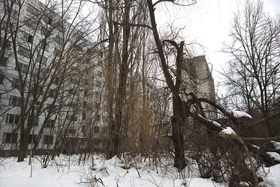Merilyn Fairskye - Precarious
Twenty-five years ago Reactor No.4 at Chernobyl Nuclear Power Plant exploded. In the aftermath, people, and radiation, were dispersed across the Soviet Union. Over 600,000 "liquidators" participated in the cleanup. 8,000 people still work there to contain the contamination. Stills Gallery is proud to present Merilyn Fairskye’s photographic series Plant Life and her film Precarious, haunting evocations of the aftermath of the explosion at Chernobyl, 25 years on. These reflections are particularly potent given the recent events in Japan.
The film Precarious is concerned with the fragility of nature and with ordinary people's capacity to endure, in the face of technological failure and state secrecy on a grand scale.
It takes the spectator on a bleak journey from the shores of the Black Sea to the frozen heart of Chernobyl, passing through desolate, snowy landscapes, littered with abandoned villages. Squatting in this icy wasteland, the ghostly sarcophagus of Reactor Number 4 is a constant reminder of the threat still lurking below. As well as footage shot in Crimea, Kiev, Chernobyl, Fairskye used the contemporary voices and stories of a range of people who have experienced Chernobyl at first hand. They include a doctor, a scientist, a teacher, a former liquidator, and a present day worker at Chernobyl. Their testimony evokes lived experience rather than history to frame the extreme uncertainty and doubt surrounding Chernobyl today. Without a linear narrative to grasp, a flow of fragments accumulates to build a sense of the utter precariousness of it all.
Accompanying Precarious are images from Fairskye’s photo series Plant Life, which were shot in 2010. They depict areas around Chernobyl. By stitching single images into panoramic views of the buildings, vegetation and the earth (which are all still contaminated), Fairskye captures evidence of vast emptiness and loss. In Plant Life/playground, a ferris wheel due to open the day after the explosion sits rusting amongst snow and trees, a potent symbol of all that has been lost. Other images show construction cranes still in place. The ruined Reactor No. 4 still contains over 200 tons of radioactive fuel and a similar amount of contaminated waste. The steel and concrete shell built onto the Reactor in the months after the disaster to contain radiation has become increasingly unstable. A billion-euro New Safe Confinement replacement designed to enclose the existing sarcophagus for 100 years, is planned to be built on site. Once in place, it is hoped that ways will be found to dismantle the underlying structure and store it, and the fuel and waste, inside safely.
Merilyn Fairskye has exhibited widely both in Australia and overseas. Her artwork encompasses a broad range of media and methods from public artwork to video installations, films and photo-based works. She teaches in the Photomedia Studio at Sydney College of the Arts, University of Sydney. Her work is held in public collections including the National Gallery of Australia, the National Gallery of Victoria, the Art Gallery of New South Wales, the Art Gallery of Western Australia, the Museum of Contemporary Art, Sydney, the Getty Collection (Los Angeles), and the Museum of Modern Art in New York (Franklin Furnace Archive).

